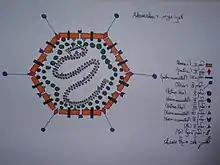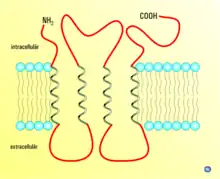Vinnexin
Vinnexin is a transmembrane protein whose DNA code is held in a virus genome. When the virus genome is expressed in a cell the vinnexin gene from the virus is made into a functioning protein by the infected cell. The vinnexin protein is then incorporated into the host's cell membranes to alter the way the hosts cells communicate with each other. The altered communication aids the transmission and replication of the virus in complex ways. The communication structure that the vinnexin is involved in is the gap junction and vinnexin forms part of a wider family of proteins that are innexin homologues referred to as pannexins.[1] So far Vinnexins have only been found in Adenovirus and the way they affect the functioning of innexins is being studied in great detail.[2]
| Vinnexin | |
|---|---|
| Identifiers | |
| Symbol | Vinnexin |
| InterPro | IPR039099 |
Discovery
Vinnexin was first described in 2005 in an adenovirus as a gene homologue of an insect gap protein called innexin.

Vinnexins were shown to be used by the adenovirus to help Incheon wasps successfully inject their eggs into the caterpillars they parasitize.[3]
Structure
The ultrastructure of Vinnexin is yet to be studied in detail. As an innexin homologue that functions in a similar way to innexins vinnexins are likely to have four transmembrane segments (TMSs) and, like the vertebrate connexin gap junction protein, vinnexin subunits assemble together to form a channel in the plasma membrane of the cell.[3]

Function
Fundamentally vinnexins have been shown to behave like the native innexins in insects. They participate in gap junctions to form transmembrane communication channels. At a higher level vinnexins must differ sufficiently from native innexins to alter the way the caterpillar host cells behave.[4][5] Without the virus with its vinnexin gene the egg of certain wasps would be rejected by the caterpillar and the egg would die. The virus and wasp are obligately associated. [6]
.jpg.webp)
[2] While the virus genes are expressed in the caterpillar the viral DNA including the vinnexin gene does not replicate its genes there. Replication of the virus including the vennexin gene occurs in the ovaries of the wasp.[7][8][9]
Transport reaction
The transport reactions catalyzed by innexin gap junctions which are considered similar to vinnexins are:
- Small molecules (cell 1 cytoplasm) ⇌ small molecules (cell 2 cytoplasm)
Or for hemichannels:
- Small molecules (cell cytoplasm) ⇌ small molecules (out)
References
- Beyer, EC; Berthoud, VM (27 May 2017). "Gap junction gene and protein families: Connexins, innexins, and pannexins". Biochimica et Biophysica Acta (BBA) - Biomembranes. 1860 (1): 5–8. doi:10.1016/j.bbamem.2017.05.016. PMC 5704981. PMID 28559187.
- Marziano, NK; Hasegawa, DK; Phelan, P; Turnbull, MW (3 August 2011). "Functional interactions between polydnavirus and host cellular innexins". Journal of Virology. 85 (19): 10222–10229. doi:10.1128/jvi.00691-11. PMC 3196458. PMID 21813607.
- Turnbull, M. W.; Volkoff, A.-N.; Webb, B. A.; Phelan, P. (2005). "Functional gap-junction genes are encoded by insect viruses". Curr. Biol. 15 (13): R491-2. doi:10.1016/j.cub.2005.06.052. PMID 16005277. S2CID 8214953.
- Zhang, Peng; Turnbull, Matthew W. (9 August 2018). "Virus innexin expression in insect cells disrupts cell membrane potential and pH". Journal of General Virology. 99 (10): 1444–1452. doi:10.1099/jgv.0.001132. PMID 30091698.
- Hasegawa, DK; Zhang, P; Turnbull, MW (7 Aug 2020). "Intracellular dynamics of polydnavirus innexin homologues". Insect Molecular Biology. 29 (5): 477–489. doi:10.1111/imb.12657. PMID 32683761. S2CID 220656169.
- B.A. Webb, N.E. Beckage, Y. Hayakawa, P.J. Krell, B. Lanzrein, D.B. Stoltz, M.R. Strand, M.D. Summers Polydnaviridae M.H.V. van Regenmortel, et al. (Eds.), Virus Taxonomy: The Classification and Nomenclature of Viruses. The 7th Report of the International Committee on Taxonomy of Viruses, Academic Press, San Diego (2000), p. 1167
- Journal of General Virology Volume 73, Issue 7, 1992, Pages 1627-1635 Persistence and expression of Microplitis demolitor polydnavirus in Pseudoplusia includens Strand, M.R., McKenzie, D.I., Grassl, V., Dover, B.A., Aiken, J.M. View Correspondence Department of Entomology, University of Wisconsin-Madison, Madison, WI 53706, United States
- Bruce A. Webb, Michael R. Strand, Stephanie E. Dickey, Markus H. Beck, Roland S. Hilgarth, Walter E. Barney, Kristy Kadash, Jeremy A. Kroemer, Karl G. Lindstrom, Walaikorn Rattanadechakul, Kent S. Shelby, Honglada Thoetkiattikul, Matthew W. Turnbull, R. Andrews Witherell, Polydnavirus genomes reflect their dual roles as mutualists and pathogens,Virology, Volume 347, Issue 1, 2006, Pages 160-174, ISSN 0042-6822,https://doi.org/10.1016/j.virol.2005.11.010.
- Marziano, N. K.; Hasegawa, D. K.; Phelan, P.; Turnbull, M. W. (9 September 2011). "Functional Interactions between Polydnavirus and Host Cellular Innexins". Journal of Virology. 85 (19): 10222–10229. doi:10.1128/JVI.00691-11. PMC 3196458. PMID 21813607.
Further reading
- Phelan P, Bacon JP, Davies JA, Stebbings LA, Todman MG, Avery L, et al. (September 1998). "Innexins: a family of invertebrate gap-junction proteins". Trends in Genetics. 14 (9): 348–9. doi:10.1016/S0168-9525(98)01547-9. PMC 4442478. PMID 9769729.
- Phelan P, Stebbings LA, Baines RA, Bacon JP, Davies JA, Ford C (January 1998). "Drosophila Shaking-B protein forms gap junctions in paired Xenopus oocytes". Nature. 391 (6663): 181–4. Bibcode:1998Natur.391..181P. doi:10.1038/34426. PMID 9428764. S2CID 205003383.
- Dykes IM, Macagno ER (April 2006). "Molecular characterization and embryonic expression of innexins in the leech Hirudo medicinalis". Development Genes and Evolution. 216 (4): 185–97. doi:10.1007/s00427-005-0048-1. PMID 16440200. S2CID 21780341.